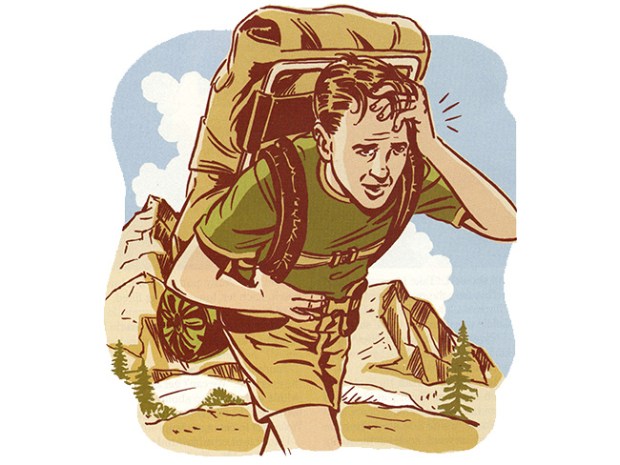How to avoid altitude sickness

Mount Elbert rises to 14,433 feet above sea level. Nothing in Colorado stands taller: the view is spectacular.
But if you ask 14-year-old Travis A. what he remembers most about Mount Elbert, it won’t be the view.
“I thought I was going to die,” he says.
He made the summit, but Travis was too sick to enjoy the moment. In fact, he blew lunch all over the side of the mountain.
Was it something he ate? Nope. The flu? No.
Instead, Travis was sickened by the altitude. And it could have been much worse. Altitude sickness can kill you.
OXYGEN AND YOU
Your body takes vital oxygen from the air you breathe. As you climb higher, the concentration of oxygen molecules (O2) in the air declines. Mountaineers call this “thin air.”
Your body may react in several ways to the reduced amount of oxygen in every breath, a condition doctors call hypoxia (high-POCKS-see-uh). Shortness of breath, especially at any exertion, is one sign that you’re getting less oxygen. Headache is another. You may have trouble sleeping at high altitude. You’ll be tired, even if you’re in great shape, You also may lose your appetite, feel nauseated or even vomit.
HAPE AND HACE
Those are nasty feelings all right, but they usually don’t mean you’re seriously sick. You’re just suffering from thin air.
Sometimes, however, high altitude can cause fluid to collect in your lungs. This is called high Altitude Pulmonary Edema (HAPE). Your chest hurts, and it gets harder and harder to breathe, even while you’re resting. HAPE can be fatal if so much fluid collects that it is impossible to breathe.
Fluid also can collect inside your skull. This is known as High Altitude Cerebral Edema (HACE). One symptom is severe headache, seemingly as if an elephant were stomping on your brain. Another is dizziness, or difficulty keeping your balance. A person with HACE can’t complete simple tasks, like walking a straight line or zipping up their sleeping bag. A severe case of HACE will squish your brain, killing you even more quickly than HAPE.
You never know when HAPE or HACE will strike. Some climbers have developed serious problems as low as 8,000 feet. Other climbers may have no trouble at all at any height, then suddenly get hit with HAPE or HACE on their 10th or 15th ascent.
If you do develop either type of edema, you must get down the mountain to “thick air” as soon as possible — don’t wait until morning (unfortunately, HACE and HAPE often strike at night). The victim must descend at least 1,000-3,000 feet. The lower you go, the better you should feel; but no matter what, you still must seek professional medical care.
It’s worth repeating: The only real cure for HAPE or HACE is to descend immediately. Anything less will not end well. If someone has a history of either, they need to talk with a doctor that is well-versed in treatment. Local urgent care facilities likely won’t be able to help.
Don’t forget to complete your BSA medical form every year!
TAKE TIME TO GO HIGH
Altitude sickness is never fun and sometimes very serious. But there are ways of preventing it. Before you climb high, a doctor may prescribe acetazolamide for you. Often sold as Diamox, this product protects you from mild sickness, but is not used for HACE. And it doesn’t have any effect on serious complications. (The only way to help those is to descend immediately!)
The best form of prevention is to take time to go high. Acclimatization, the process of adjusting your body to altitude, takes time. How much? Well, if you’re climbing to less than 6,000 feet, acclimatization probably is unnecessary. Acute mountain sickness can occur at 6,000 feet but more often occurs at 8,000 or above.
If you’re going above 10,000 feet, however, spend a day or two just below that before pushing higher. And when you do, don’t gain more than 1,000 feet per day unless you can drop back to within 1,000 feet of where you were the previous day to sleep. For example, if you sleep one night at 11,000 feet, you can climb up to say, 14,000 feet, but then, assuming you don’t have any symptoms, you should descend to 12,000 feet to sleep the second night.
Because you can blow off a lot of water with all the huffing and puffing, it’s important to drink extra water to avoid dehydration, and to avoid overexerting yourself.
Between old age and COPD, my trip to visit son and daughter-in-law in the mountains outside of Denver didn’t go as planned. I spent the first week in ICU with altitude sickness. Took me almost 6 weeks to adjust to the altitude even with constant oxygen. Wasn’t the least bit fun. All I can say is take your time to adjust to the altitude.
I am going to be heading to Colorado next month. The family wants to drive up pikes peak but I have not been up there since I was a teenager. I am also very overweight, I am worried about going up. Should I stay behind while everyone else goes or do you think it would be safe for me to attempt?
So that’s what happened to me when I climbed to 14,000 feet a couple of months ago. I stay in reasonably good shape when I’m home (at sea level) but found it quite difficult to breathe above 10,000 feet. Very informative, thanks!
altitude dosnet effect me i live at 6500 feet and when we went on a backpacking trip at 12500 feet everyone but me had trouble and i have ashama though its probibly couuse i live at 6500 ft which is cool so the artical didnt help me
i am just about to do a high altitude trip, this really helped
Thanks for the tips, especially about HAPE and HACE.
what he said
Cool.